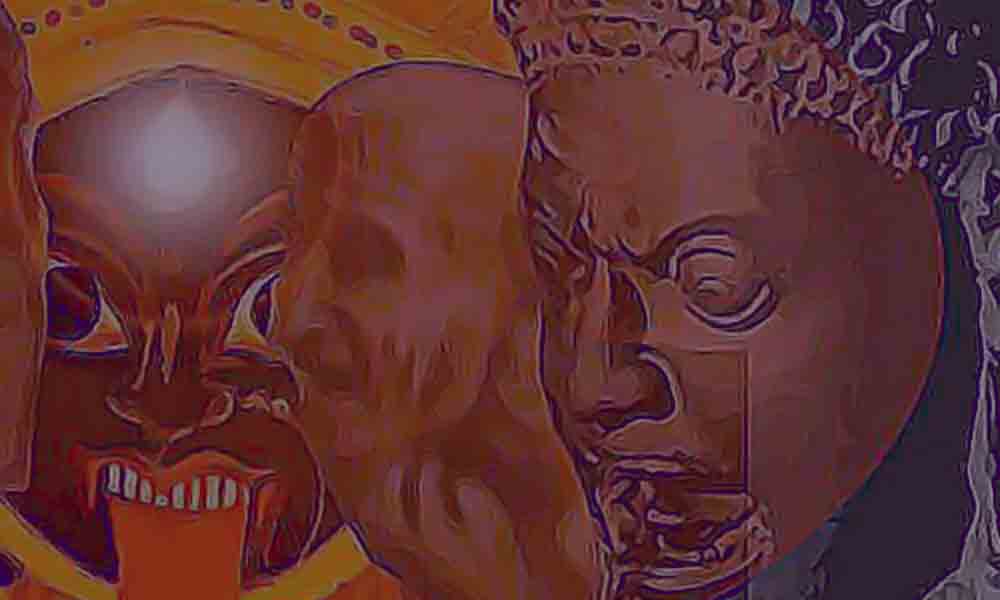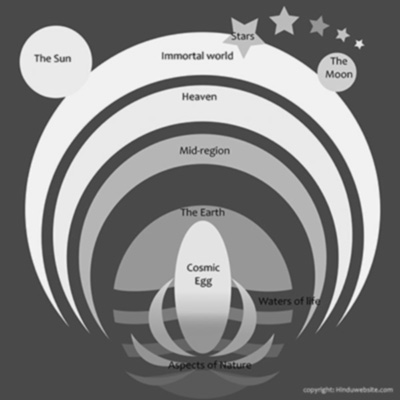
The Symbolism of Time or Kala and Death in Hinduism

What is the most distinguishing feature of this world compared to the other worlds? In this article we will explore this subject and its symbolic significance. The Vedas recognize a four tier world, the earth, the mid-region, the sky or the heaven and the world of Brahman in the region of the sun.
In addition to this there are two other worlds mentioned in the hymns: the underworld or hell and the ancestral world in the region of the moon. This was the basic concept of cosmos as described in the Vedas, especially the early Upanishads.
A more elaborate cosmic structure consisting of 14 worlds emerged later during the time the Puranas were written, in which the earth was the seventh from above. The folowing image 1 shows the concept of the cosmos as described in the hymns and verses of the Vedas and Upanishads.
In this cosmos, the immortal gods live in Indra's heaven. The immortal souls who achieve liberation or self-realization live in the immortal world of Brahman. The mid-region is the region of life sustaing air, light and rain. It superior to the earth. It is where gods and humans interact.
When a person dies, his breaths (pranas) along with the deities in the sense organs escape into this region and disperse from there. It is in this region the immortal northern path to the world of Brahman (uttarayana) and the inferior southern path to the world of ancestors (dakshninayana) separate and go their respective ways.

The Upanishads describe air as an absorber. It absorbs things including the life-breath of those who die. It is where the sun and the moon appear everyday and from where they also disappear. This region is special because it supports life by provdiing breath and the light of the sun and serves as the sphere of the celestial beings, such as the Yakshas and Gandharvas, who inhabit the middle planes and enjoy a much longer life-span than ours.
In the human body, which is comparable to the cosmos, the organs of action represent the earth. The five breaths, namely prana, apana, vyana, samana and udana, represent the mid-region. The circulate in the body along subtle channels called nadis in various directions.
The Upanishads describe breath as the most superior function in the body, to which all the organs are subordinate. It is impervious to evil, since it is beyond desires. Your sense organs are motivated by desires, but your breath functions ceaselessly whether you like it or not, whetehr you are asleep or awake. Hence, it is impervious to evil.
Next to the breath is the mind, which along with the senses represent Indra's heaven. Intelligence is Brahman (prajnanam brahma). Hence it represents the world of Brahman.
What distinguishes our world from the rest is mortality. Every living being upon earth is subject to death and rebirth. Death, thus, rules our lives. None can disobey its commands. Whoever comes into this world and assumes a body is subject to death. It is true even case of an incarnation.
The development of Vedic philosophy was centered around this most important feature of our existence. In fact the Vedas are meant to be a solution to this problem. All the ritual and spiritual practices prescribed in the Vedas are meant to resolve this fundamental problem of our existence. Every religion and traditoin that originated int he Indian soil subsequently tried to address in their own ways.
The Upanishads, therefore, describe Death as the Lord of creation or creation itself. Our macrocosm (the world), just as our microcosms (bodies) represent Death. The Brihadaranyaka Upanishad (1.2) describes how Death manifested. "In the beginning, there was nothing here whatsoever. Indeed, by Death only all this was enveloped, or by hunger, because hunger is death only. He created the mind thinking, “Let me have a mind.” Then, He performed worship. From that worship, water was produced. He thought, “Truly while I was worshipping, water was produced. That is why water is called Arca. Surely, water comes to him who thus knows why water came to be known as Arca.”
This Death then created time and diversity. All that was created by him became his food. The Upanisahds further states, "Whatever He manifested, all that He decided to eat. Because He eats everything, indeed the nature of Aditi is called Aditi." Then to continue the manifestation he sacrificed himself.
Thus, the physical material world and the body in us represent Death. Since Death rules them they are subject to change and decay. Our bodies, organs of action and sense organs are subject to fatigue because Death rules them. The only entities in the body which Death cannot touch are breath and the Self.
Hence, the Upanishads state that they are the superior deities in the body and he who wants to escape from Death should take refuge in them. With the help of breath one should restrain the mind and restrining the mind one should stabilize the intellect in the innrt Self. Perfection in the practice leads to the state of self-absorption (samadhi) in which one perceives the Self as one's essential nature.
Another name give to Death is Kala or time. Time rules our lives. We depart from here when our time comes. The fate of everythign in the mortal world is shaped and controlled by Time only. Hence in Hinduism Time or Kala is equated with death. Time is one of the highest aspects of Manifested Brahman. He manifested before the worlds and beings manifested. Hence he is the foremost among the deities.
He is the same God whom Lord Krishna manifested before Arjuna in the battlefield of Kurukshetra. In the Bhagavadgita (11.32), when Arjuna asks who he was, he replies, "I am Time, the Destroyer of the worlds, vast and mighty, who manifests to destroy the worlds. Even without you, all the warriors who are standing on the other side will cease to exist.
Suggestions for Further Reading
- Om, Aum, Pranava or Nada in Mantra and Yoga Traditions
- Brahmacharya or Celibacy in Hinduism
- Atheism and Materialism in Ancient India
- Solving the Hindu Caste System
- How To Choose Your Spiritual Guru?
- Creation in Hinduism As a Transformative Evolutionary Process
- Wealth and Duty in Hinduism
- Do You Have Any Plans For Your Rebirth or Reincarnation?
- Understanding Death and Impermanence
- Lessons from the Dance of Kali, the Mother Nature
- Letting your God live in You - The True Essence of the Hindu Way of Life
- prajnanam brahma - Brahman is Intelligence
- Maslow's Hierarchy Of Needs From The Perspective Of Hinduism
- The Defintion and Concept of Maya in Hinduism
- The Meaning of Nirvana
- Self-knowledge, Difficulties in Knowing Yourself
- Hinduism - Sex and Gurus
- The Construction of Hinduism
- The Meaning and Significance of Heart in Hinduism
- The Origin and Significance of the Epic Mahabharata
- The True Meaning of Prakriti in Hinduism
- Three Myths about Hinduism
- What is Your Notion of God?
- Why Hinduism is a Preferred Choice for Educated Hindus
- Essays On Dharma
- Esoteric Mystic Hinduism
- Introduction to Hinduism
- Hindu Way of Life
- Essays On Karma
- Hindu Rites and Rituals
- The Origin of The Sanskrit Language
- Symbolism in Hinduism
- Essays on The Upanishads
- Concepts of Hinduism
- Essays on Atman
- Hindu Festivals
- Spiritual Practice
- Right Living
- Yoga of Sorrow
- Happiness
- Mental Health
- Concepts of Buddhism
- General Essays
1. Reproduced from the Selected Upanishads 2013, by Jayaram V with the permission of the Publishers, Pure Life Vision LLC.